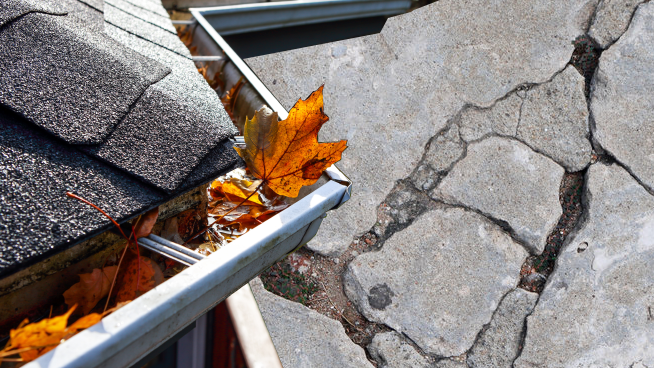Here are some tips for maintaining this system:
Clean them regularly: Leaves, debris, and other materials can accumulate in your gutters and prevent water from flowing properly. Regular cleaning can prevent clogs and ensure that your gutters are functioning correctly.
Regular inspections can help you identify any damage or wear and tear on your gutters. Check for any cracks, holes, rust or loose fasteners. Damaged gutters can lead to leaks and water damage, so it’s essential to address any issues promptly. A pair of binoculars can help you see issues from the ground if you can’t get on the ladder.
Make certain the back edge of gutters is tucked up under the metal drip edge on the roof.
Trim trees near your roof edge: Trees that overhang your roof can drop leaves and branches into your gutters, leading to clogs. Regular tree trimming can prevent this issue.
Make sure the extensions on your downspouts don’t get crushed by your lawnmower or dig themselves into the ground by being in the same place for too long. Downspout extensions should have a small hinge on them so they can be moved up and out of the way when mowing your lawn.
An alternative to long extensions is to bury a length of sleeved plastic pipe just below the sod and turn the downspout end into the pipe to carry water away from the home. A 12-to-20-foot length is inexpensive and easily buried in the spring.
Professionals will terminate this pipe at a lawn sink with a grate so excess water during heavy rains will simply bubble up on the grass well away from the foundation.
Install gutter guards: Gutter guards can help prevent debris from entering your gutters and can reduce the frequency of cleaning.
There are several types available to you and the Guys have great referrals at our website for designers and installers.
Gutter maintenance is essential to prevent water damage to your home’s roof, walls and foundation. Regular cleaning, inspections and repairs can help ensure that your gutters are functioning correctly.
When homeowners see concrete separation, whether it be a random crack, or the joints between the individual slabs, the immediate reaction is to fix it using cement, which is a common mistake.
Caulks like Sikaflex and Slab are a type of sealant that can be used to fill in gaps and cracks in concrete. They can be purchased in a standard 10.5-ounce tube and give homeowners the option of trowel able or self-leveling product. The Guys suggest trowel able for DIYers. Once it dries, it forms a strong bond with the concrete surface and provides a long-lasting repair.
When using caulk to repair cracks and joints in concrete, clean the area thoroughly with a wire brush or a pressure washer to remove any debris and loose material.
Then, apply the material into cracks or joints using a caulking gun.
After applying the caulk, smooth it out with a soapy kitchen teaspoon. Keep dipping the spoon in soapy water and have a rag ready to clean the spoon as you go. Let it dry for a few hours and your repair is complete. Painters tape on both side of the joints work great for a consistent, straight-line, look.
Cement is a rigid material, and it does not have the flexibility to move with weather and moisture variations. As a result, it will eventually crack and fail to hold the repair. On the other hand, urethane and acrylic caulk is a flexible material that can move with the concrete surface, making it an ideal choice for repairing cracks and joints.
The proper caulk is a flexible and long-lasting material that can provide a strong bond with the concrete surface. So, if you have cracks or joints that need repairing, consider using caulk instead of cement. You can also find companies that specialize in this kind of work at the InsideOutsideGuys.com.








